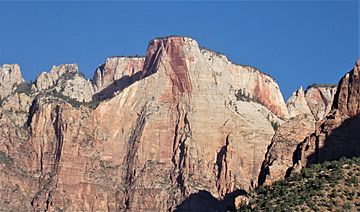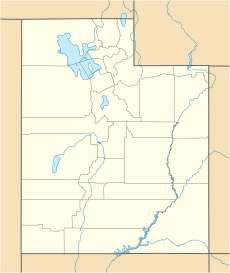Altar of Sacrifice facts for kids
Quick facts for kids Altar of Sacrifice |
|
|---|---|

Altar of Sacrifice, east aspect
|
|
| Highest point | |
| Elevation | 7,505 ft (2,288 m) |
| Prominence | 585 ft (178 m) |
| Isolation | 0.74 mi (1.19 km) |
| Parent peak | The Sundial (7,590 ft) |
| Geography | |
| Location | Zion National Park Washington County, Utah United States |
| Parent range | Colorado Plateau |
| Topo map | USGS Springdale West |
| Geology | |
| Age of rock | Jurassic |
| Type of rock | Navajo sandstone |
| Climbing | |
| Easiest route | class 5+ climbing |
Altar of Sacrifice is a tall mountain peak in Zion National Park, located in southwest Utah, United States. It stands at 7,505 feet (2,290 meters) above sea level. This impressive mountain is made of Navajo Sandstone, a type of rock formed from ancient sand dunes.
Contents
About Altar of Sacrifice
Altar of Sacrifice is a major landmark in Zion National Park. It is about 2.5 miles (4 kilometers) west-northwest of the park's main office. This mountain rises an amazing 3,500 feet (1,060 meters) above the bottom of Zion Canyon. The Virgin River flows through the canyon below, carrying away rainwater from the mountain.
Nearby Mountains
Altar of Sacrifice has many interesting neighbors. Its closest taller peak is The West Temple, which is about one mile to the south. Other mountains nearby include The Witch Head, Meridian Tower, Bee Hive, The Sentinel, Mount Spry, Bridge Mountain, and Mount Kinesava.
How Altar of Sacrifice Got Its Name
The name "Altar of Sacrifice" was given by a minister named Frederick Vining Fisher in 1916. He also named other famous spots in Zion Canyon, like The Great White Throne and Angels Landing.
Why the Name Fits
The mountain got its name because of dark red stains on its east side. These stains are caused by hematite, which is a type of iron oxide. They look like large amounts of blood have been spilled from the top. This made people think of an altar where sacrifices might have happened. The name "Altar of Sacrifice" was officially approved in 1934 by the United States Board on Geographic Names.
Weather at Altar of Sacrifice
The best times to visit Altar of Sacrifice are during spring and fall. The weather is usually mild and pleasant then.
Climate Type
This area has a Cold semi-arid climate. This means that the coldest month of the year has an average temperature below 32 °F (0 °C). Also, at least half of the yearly rain falls during spring and summer.
Rainfall and Snowfall
The desert climate here means it doesn't get much rain, usually less than 10 inches (250 mm) per year. Snowfall in winter is generally light.
Images for kids
-
The West Temple (left), The Sundial, The Witch Head, Altar of Sacrifice (right)
-
Towers of the Virgin. Left to rightː The Sundial, The Witch Head, Broken Tooth, Rotten Tooth, Altar of Sacrifice (upper right).
-
Altar of Sacrifice (centered) seen from summit of The Watchman








